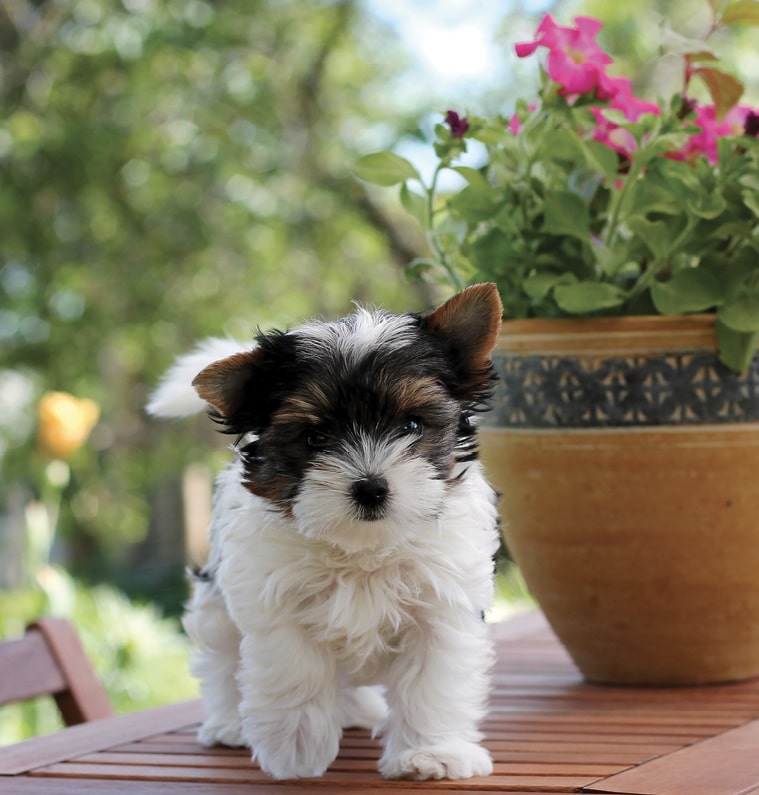Litter Size and the Singleton Puppy | History and experience have demonstrated that when two or more breeders gather together, their conversation, oftentimes, centers on the number of pups born and what might have gone wrong. For years, breeders have speculated as to why some litters are larger than others. Since most breeders do not review the literature and are not trained in biology or in veterinary medicine, a review of these questions was addressed.
Background
A review of how nature has addressed these topics shows us that animals adapt to their living conditions. For example, horses and cattle live in herds as herbivores and cover considerable distances each day. They tend to have a long period of gestation and produce a single offspring. Their young are born among the herd as it moves slowly, because only in the middle of the great herd can they be protected. The problem is quite different for canines. They live in small communities and their young are born in a safe hideout. Because they hunt, they cannot afford a long period of gestation. The reason that carnivores usually do not have single offspring litters stems from the nature of their existence. They must be constantly hunting to struggle for existence, and the casualties among their young are high. Severzov calculated that the morality among young wolves was 45 percent at the end of the first year, and a further 32 percent by the end of their second year, with a total loss of about 77 percent for all young wolves. If their litters consisted of only a few pups, the likelihood would diminish that the survivors could contribute to maintaining the survival of the species.
There are several ways to approach the study of litter size in dogs. One perspective is to look at what can influence the size of a litter; another is to study one-puppy litters. Goldbecker and Hart reported experiences with both. For the one-puppy litters, they suggested the use of foster mothers and treating the singleton as an orphan because they have similar problems. They believed that these pups needed siblings (or other dogs to interact with) in order to learn the rules of the dog world. To that end, it is generally accepted that, at least for canines, littermates provide valuable and necessary practice sessions. Interactions provide opportunities for using their teeth, developing eye contact, and a wide range of other canine behaviors that become useful as adults.
Most of the small breeds, notably the Toys and Terriers, usually produce very small litters. This is, in part, because of their very small size, which limits their capacity to carry large litters. But in the larger breeds there are wide variations in litter size, ranging from 1 to 21 and, in some instances, they have been larger. Breeders have, for years, unsuccessfully tried to make improvements in litter size via breeding and selection techniques—with little success. While many traits have high heritability, litter size is not one of them. It has a low heritability (around 10-15 percent), which means that one cannot count on the genes to increase the number of pups born. What can be expected will largely be determined by the non-additive factors of dominance. For example, wither height has a heritability estimate of 40-65 percent, which is reasonably high. Therefore, it is relatively easy for the breeders of the German Shepherd Dog to produce offspring with high withers. However, when it comes to litter size, selecting parents that come from large litters will not improve the number of pups born. However, the physical condition of the dam at the time she is bred has been shown to increase or decrease litter size, depending on her body condition and muscle tone. For example, obese bitches tend to have smaller litters than those that are fit and trim. Nutrition is still another factor that was suspected to affect litter size. Some thought it would vary between and within breeds. The fact that there are large breed variations in litter size attracted the attention of Russ Kelly, a noted nutritionist. He set out to better understand litter size by examining what would happen if nutrition became the variable. What he found was that the diet fed to bitches during their pregnancy did influence the size of their litters. To do this, he studied three colonies of bitches that were in whelp. One colony was fed only a dry ration of good quality dog food. The second was fed the same dry ration, but supplemented with cottage cheese. The third was fed the same dry ration with supplements of cottage cheese and meat. The important point here is that two of the three colonies were fed extra protein supplements. The colony that had the largest number of pups born alive came from mothers not fed any supplements. His findings made clear that supplementing a high quality, nearly perfectly formulated dog food with rations of cottage cheese and other meat products would interfere with the number of pups born alive. In other words, supplements added to a good quality commercial dog food reduces the chances for larger litters. This finding is good news to many dog breeders. Many of today’s commercially prepared dry dog foods are nearly perfectly formulated foods. Adding supplements to these foods alters the formula with unintended consequences. Feeding pregnant females a puppy food during their gestation period is also not recommended.

Singleton Pups
The singleton pup is a one-puppy litter. To better understand these pups and their development, three general questions were used. They each were designed to focus on the whelping process, behavior during and after weaning, and the effects of the dam on her pup during its development. While many species have single births and small litters, the canine is not generally considered to be one of them, even though there are many breeds that only produce one or two puppy litters. Small litters can be directly related to the selective breeding practices that breeders have used over the years to fulfil the physical size requirements of their breed standards. The other explanation given to explain the variations in litter size has been demonstrated to be nutrition
and conditioning.
Since there is no body of literature on this subject, other than the works of Kelley that was mentioned previously, several breeders and veterinarians were contacted who had reported experiences with single puppy litters. Many of the breeders stated that a singleton pup could become a little dog aggressive, less sociable, and a little more “abnormal” than an average pup born with littermates. This would make sense because they did not have the opportunity to learn about biting and nipping from their littermates. Others reported that singleton puppies were not problem pups until they started to take notice of their surroundings, post weaning. All of the breeders interviewed had also produced pups with large litters and, thus, had some basis for making the comparison. Most of these breeders assumed that a singleton would be larger than normal, thus producing delivery problems that resulted in a “C” section.
Veterinarians, on the other hand, reported a wide range of different experiences that did not necessarily agree with those indicated by the breeders. Most veterinarians said that a singleton was not larger, stronger or smarter than others of the same breed when they compared them with pups from larger litters. They also noted that the singleton did not necessarily make a better companion when they were adults. Only a few of the respondents reported that they noticed adult behavior problems, even though many singletons lacked interaction
with littermates.
Based on the experiences of these two groups, the recommendations that can be offered suggest a number of approaches. Apart from having no littermates to interact with, the lack of companionship could be compensated for if the dam is encouraged to provide daily stimulation and attention. Puppies learn to be a dog by being part of their “pack” in the nest. Keeping the singleton occupied was found to be important, and most recommended handling by different individuals to keep them from becoming bored. While most dams naturally encourage their pups to play, they also teach them good manners. As soon as a singleton is old enough, they should either go to their new home (eight weeks is early enough) or have them introduced to owners with other dogs.
Three breeders who had a singleton pup produced by frozen semen were also contacted. All reported that the pups were of normal size for their breed (Afghan Hound, Whippet, and German Shepherd Dog). The dams of these singleton puppies had produced average litters before and after the singleton. The cause for the singleton litter, according to these breeders, was the use of frozen semen. All of the sires had previously produced average size litters. The breeders of these frozen semen litters indicated that it was just bad luck that only one pup occurred. All of these singletons were born naturally, except the one produced from 16-year-old semen. Most of the dams had had a previous litter naturally. The classic reason for singletons being born by Caesarian does not seem to be related to the use of frozen semen. It is more likely to be issues with the semen, its handling or bad timing for the breeding.
The conclusion that one can draw from this material is that breeders of a singleton should take extra care to be sure that they are occupied and do not become bored. Since most dams can only provide a limited amount of playtime, these pups should be given more opportunities to play with others (Malcolm Willis). Playgroups were suggested as excellent ways for singletons to learn the social rules of the canine species. All agreed that supervision by humans should not be ignored, because the singleton can be injured during unintentionally rough play.
The group was asked about the singleton when it had become an adult. While this study was limited to several breeders and veterinarians, the respondents all agreed that the bitches involved in this limited study were considered to be good mothers and had plentiful supplies of milk. Most seemed to pay attention to their one pup, and none were overprotective or lacking in maternal interest. Some of the singletons were raised in a home environment as opposed to a kennel. Most of the pups studied received adequate amounts of supervision and were given early human socialization, perhaps more than what would normally have been provided while in the nest with a litter. In order to fill the gap involving the lack of stimulation, some were placed with other litters. All grew to be normal and healthy. Most, but not all, were considered
well-adjusted adults.
It is not hard to see why swimmers and runts have several things in common with the singleton. During the first few weeks after birth, they all tend to be hand-raised. They are given so much physical attention and handling that they can be categorized as being treated as a singleton. The differences between them are that most swimmers and runts do not grow up to look like their littermates, and few ever become good show or good working dogs. Because they are given so much attention and handling, the human bond generally is very good and most make wonderful pets.
Based on a review of this complex subject, and the answers gathered, it seems fair to use a conclusion reached by Scott and Fuller in the 1950s. While they did not study singletons and litter size, per se, they did study differences between breeds and individuals within a breed. One of their conclusions was that there are measurable differences between breeds that are both physical and behavioral. They found that although there is a great deal of overlap between breeds, the individual capacities they will have are likely to be highly variable. They also found that most pups that become great performers, and the ones that are able to perform extraordinary tasks, seem to have different capacities. In short, they “probably have special combinations of certain capacities, which are largely the result of accidental selection.”
For more information about breeding, pedigree analysis, pedigree software, and the selection of sires, go to: www.breedingbetterdogs.com.
Purchase your copy of Dr. Battaglia’s book
“Breeding Better Dogs”, or his DVD on “Choosing the Best Puppy” in the Showsight Magazine Shop at: showsightmagazine.com/shop.
References:
Goldbecker, W. and Hart, E., This is the German Shepherd, T.F.H. Publications Inc., Jersey City, NJ 1964, p.125.
Kelley, Russ, Recent Advances in Canine and Feline Nutrition, Vol. III, 2000 Iams Nutrition symposium proceedings; “Canine reproduction: What should we Expect?” Orange Frazer Press, Wilmington, OH 2000, p. 225-239.
Severzov, Adrian and Owen, Ray, General Genetics, W. H. Freeman and Company, San Francisco, 1957, p 503.
Scott, J.P. and Fuller, J. L., Dog Behavior, the Genetic Basis. University of Chicago Press, Chicago, Ill.1965, p.366-367.
Trumler, Eberhard, Understanding Your Dog, Faber and Faber, 3 Queens Square, London. 1973, P. 56
Willis, Malcom, The German Shepherd Dog: A Genetic History, Howell Book House, New York, NY 1995, p. 289-293.










